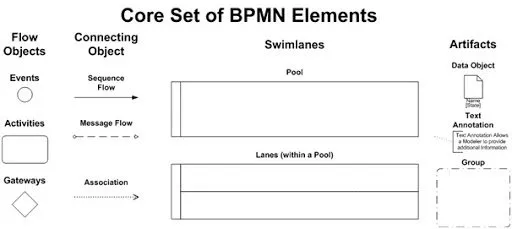What is the BPMN 2.0 Standard?
Blog: ProcessMaker Blog
Business Process Model and Notation (BPMN) is widely used by both business owners and technical users to design and implement business processes. Yet BPMN 2.0, a 500+ page ISO standardized specification, can be confusing to those unfamiliar with business process management. Keep reading for a brief overview of what BPMN 2.0 is, its history, uses, benefits, and BPMN 2.0 elements and symbols.
What is BPMN 2.0?
BPMN 2.0 is an open standard notation system based on a flowcharting technique that is used to model business processes. The standard is widely used in business process management since it is easily understood by business users while also providing technical users with the ability to represent and implement complex processes.
BPMN 2.0: a brief history
BPMN was originally developed by the Business Process Management Initiative (BPMI) in 2004. In 2005 BPMI merged with the Object Management Group (OMG). One year later BPMN was formally adopted as a standard by OMG. BPMN 2.0 was developed in 2010 but was not released until 2013. The standard was officially published by the International Organization for Standardization (ISO) that same year – ISO/IEC 19510.
BPMN 2.0 uses and benefits
BPMN 2.0 is used to build easy to follow business process model flowcharts. Like other business process modeling tools, BPMN 2.0 helps stakeholders gain a better understanding of a process through a universally understood language. The visual representation of the steps involved in a business process makes it easy for business users to understand how a process works. At a more technical level, BPMN 2.0 provides enough detail to implement a process.
BPMN 2.0 also helps to close the gap between the various stages of business process management, making it easier to move from business process design to implementation. This is largely due to the intuitive level of understanding that BPMN 2.0 provides, giving stakeholders that serve different functions the ability to work together.
Another major advantage of BPMN 2.0 relative to other business process modeling tools is that business process diagrams which utilize BPMN 2.0 can be seamlessly converted into process models through XML based BPMN format.
BPMN 2.0 elements and symbols
As a standard language, BPMN utilizes symbols. The symbols fall into four main groups:
- Flow objects. Form the overall workflow. The three main flow objects are called events, activities, and gateways. Events are triggers that start, alter, or complete a process. Activities are tasks performed by individuals or technology. Gateways are decision points.
- Swimlanes. A pool includes the participants in a process. Swimlanes show the activities for each participant.
- Connecting objects. Illustrate how the elements of a process relate to one another. There are three types of connecting objects: sequence flows, message flows, and associations. Sequence flows show the order that activities will be performed. Message flows show communications between departments. Associations shows the relationship between an artifact to an event, activity, or gateway.
- Artifacts. Artifacts are used to provide additional information about a process. There are three types of artifacts: data object, group, and annotations. Data objects show what data is required for an activity. Groups show the logical grouping of activities. Annotations are used to explain various aspects of the diagram.
ProcessMaker’s low-code business process management software makes it easy to design, test, and implement business processes with BPMN 2.0.
The post What is the BPMN 2.0 Standard? appeared first on ProcessMaker.
